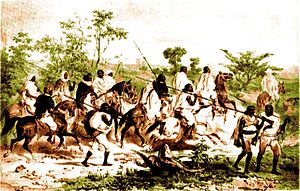Battle of Metemma
| Battle of Gallabat | |||||||
|---|---|---|---|---|---|---|---|
| Part of the Mahdist War | |||||||
 Ethiopian warriors (circa 1845) |
|||||||
|
|||||||
| Belligerents | |||||||
|
|
|
||||||
| Commanders and leaders | |||||||
| Zeki Tummal | Yohannes IV of Ethiopia † | ||||||
| Strength | |||||||
| 85,000 men | 130,000 foot soldiers, 20,000 cavalry | ||||||
| Casualties and losses | |||||||
| 15,000 killed? | 15,000 killed? | ||||||
The Battle of Gallabat (also called the Battle of Metemma) was fought 9–10 March 1889 between the Mahdist Sudanese and Ethiopian forces. It is a critical event in Ethiopian history because Nəgusä Nägäst (or Emperor) Yohannes IV was killed in this battle. The fighting occurred at the site of the twin settlements of Gallabat (in modern Sudan) and Metemma (in modern Ethiopia), so both names are commonly used and either can be argued to be correct.
When the Mahdists rebelled against the Egyptians, many Egyptian garrisons found themselves isolated in Sudan. As a result, the British, who had taken over the government of Egypt, negotiated the Treaty of Adowa with Emperor Yohannes IV of Ethiopia on 3 June 1884 whereby the Egyptian garrisons were allowed to evacuate to Massawa through Ethiopian territory. After that, the Mahdist Khalifa, Abdallahi ibn Muhammad, considered the Ethiopians as his enemies and sent his forces to attack them.
The twin communities of Gallabat and Metemma were located on the trade route from the Nile to Gondar, the old Imperial capital; the Mahdists used these communities as their base for attacks on Ethiopia. These raids led to a Mahdist defeat by Ras Alula on 23 September 1885 at Kufit.
A few years later, the negus of Gojjam, Tekle Haymanot (a vassal of Emperor Yohannes) attacked the Mahdists at Metemma in January 1887, and sacked the town. In response, that next year the Mahdists under Abu Anga campaigned out of Metemma into Ethiopia; their objective was the town of Gondar. Tekle Haymanot confronted him at Sar Weha on 18 January 1888, but was badly defeated. The Mahdists proceeded to Gondar, and set about ransacking the town. Churches were pillaged and burnt, and many inhabitants were carried away into slavery.
...
Wikipedia
